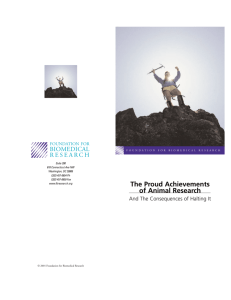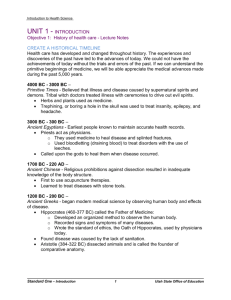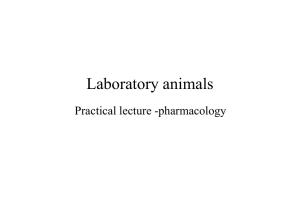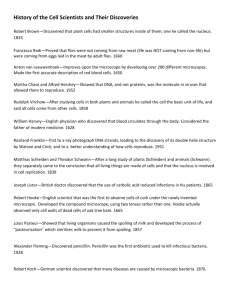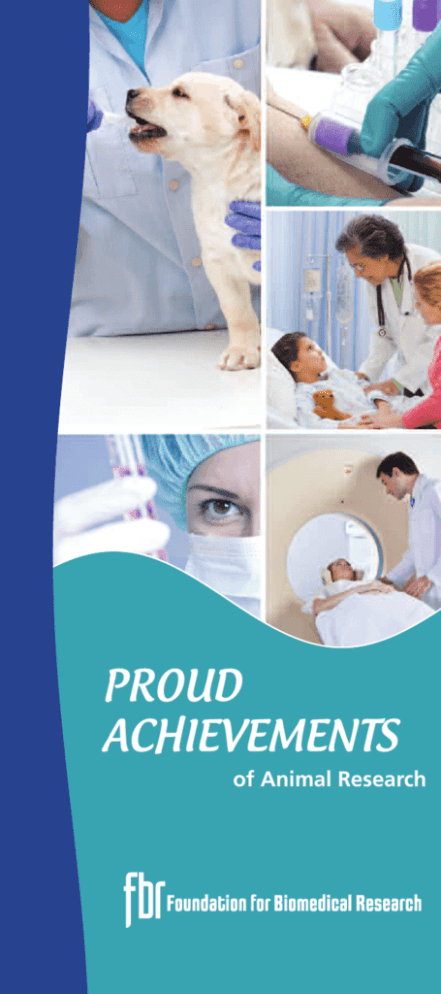
PROUD
ACHIEVEMENTS
of Animal Research
Animal research
has played a vital
role in virtually
every major medical
advance of the last
century – for both
human and
animal health.
2
F
rom the discovery of antibiotics, analgesics,
antidepressants, and anesthetics, to the
successful development of organ transplants,
bypass surgery, heart catheterization, and joint
replacement – practically every present-day
protocol for the prevention, control, cure of
disease and relief of pain is based on knowledge
attained – directly or indirectly – through research
with animals.
Since the dawn of medical science, physicians and
researchers have been struck by the physiological
and genetic similarities between humans and
animals. Even a tiny creature like a fruit fly, which
is so physically different from a human in many
ways, still shares many genetic and physiological
similarities with humans. Incredible insights drawn
from studies with lab animals have been critically
important in the design and proper interpretation
of human studies, despite what some opposing
forces may say. Studies of human populations
and clinical cases could not be interpreted without
the basic scientific understanding that came from
centuries of research with animals.
The essential need for animal research is
recognized and supported by scientists, medical
societies, and health agencies around the world.
The following pages represent a brief chronicle
of the dramatic progress in recent years that has
been made in the prevention and treatment of
a myriad of diseases. In every case, critical steps
in the basic understanding of the disease and
knowledge of how to combat it came from
animal-based research.
3
✓
✓
✓
✓
✓
4
Since 1900, modern medicine and public
health have boosted the average life span
in the United States by almost 30 years.
Between 2001 and 2007, the overall U.S.
five-year survival rate for cancers
increased by 67 percent.
Between 1950 and 2011, U.S. deaths
from stroke and heart disease fell by
70 percent and 63 percent, respectively.
Between 2001 and 2011, AIDS-related
deaths in the U.S. fell by 25 percent.
Safe and effective vaccines have been
developed to control the following
common diseases, once regarded as
“killers”: polio, measles, diphtheria,
whooping cough, rubella,
mumps, tetanus,
influenza and
pneumococcal
pneumonia.
Infant Mortality
In 2010, infant mortality in the US — a key indicator
of the nation’s health — was measured at fewer than
seven deaths per 1,000 live births compared to 47
deaths per 1,000 live births in 1940. Much of this
progress came from knowledge gained through
animal research.
Vaccines and Survival
Many diseases that once killed millions of people every
year are now either preventable, treatable or have been
eradicated altogether. Immunizations against polio,
diphtheria, mumps, rubella and hepatitis have saved
countless lives. Animal research played a crucial role in
developing these vaccines. The survival rates for many
other major diseases are at an all-time high thanks to
the discovery of powerful new drugs, the development
of new surgical procedures and the design of
sophisticated medical devices.
Animal Research Helps Animals
Dogs, cats, sheep and cattle
also are living longer and
healthier lives thanks to
vaccines for rabies, distemper,
parvo virus (infectious
diarrhea), infectious hepatitis,
anthrax, tetanus and feline
leukemia. And new
treatments for glaucoma,
heart disease, cancer, hip
dysplasia and traumatic
injuries are saving, extending
and enhancing the lives of beloved companion animals
while advanced reproductive techniques are helping to
preserve and protect threatened species. Pacemakers,
artificial joints, organ transplants and freedom from
arthritic pain are just a few of the breakthroughs made
in veterinary medicine thanks to animal research.
ANIMAL
RESEARCH FOR ANIMAL
HEALTH ALSO HAS
RESULTED IN MANY
REMARKABLE
LIFESAVING AND
LIFE-EXTENDING
TREATMENTS FOR CATS,
DOGS, FARM ANIMALS,
WILDLIFE AND
ENDANGERED SPECIES.
5
Mice, rats and other rodents
make up the vast majority of
lab animals.
Find out what researchers have
achieved with the help of mice,
rats and other rodents.
Stem Cells
PARALYSIS
FROM ACUTE SPINAL
CORD INJURIES MAY
EVENTUALLY BE
REVERSED BY NEW
SPINAL CORD
THERAPIES.
Teams of scientists are now
identifying the therapeutic
potential for transplanting
both embryonic and adult
stem cells for a wide range of
therapies in such devastating
diseases as cancer, Alzheimer’s
and Parkinson’s disease.
Anti-Cancer
90.4 PERCENT
OF AMERICAN
CHILDREN SUFFERING
FROM ACUTE
LYMPHOCYTIC
LEUKEMIA REMAIN
IN REMISSION FOR
AT LEAST FIVE YEARS.
Dramatic improvement in
the treatment regimens
with novel anti-cancer
drugs permits 90.4 percent
of American children
suffering from acute
lymphocytic leukemia to
remain in remission.These
long-term survivors often go
on to lead normal lives.
Antibiotics
Improvements in antibiotic
therapy have helped extend
the lives and improve the
lung function of some 30,000
young people with cystic
fibrosis, a deadly congestive
lung disease.
6
Anti-Psychotics
As many as two million Americans living with bipolar
disorder (manic-depression) and schizophrenia can
function normally, thanks to a variety of new, longacting anti-psychotic drug therapies.
Lower Risks
Fast-acting medications have significantly reduced the
risk of death of patients suffering from heart attacks,
asthma, and other allergenic diseases.
Paralysis
Millions of people, particularly young men, suffer
acute spinal cord injuries each year as a result of
accidents. Scientists are now finding potential new
spinal cord therapies to spur neurons to grow and
create new connections, enabling recovery of
sensations and motor functions. Eventually, paralysis
may be reversed.
Statins
A widely prescribed class of
drugs known as “statins” can
block plaque buildup in arterial
walls and reduce the incidence
of heart attacks. Newer
“statins” with improved efficacy
show beneficial secondary
effects in the treatment of
coronary heart disease, stroke,
multiple sclerosis, osteoporosis
and Alzheimer’s disease.
INSULIN
SKIN PATCHES, SPRAYS
AND INHALERS ARE
MAKING LIFE EASIER
FOR THOSE WHO LIVE
WITH DIABETES.
7
MORE THAN
100 MILLION DOSES
OF THE FLU VACCINE
ARE PRODUCED
ANNUALLY FOR
THE U.S.
NEW
ANTI-MALARIAL
AGENTS HAVE BEEN
DEVELOPED TO
PROTECT MILITARY
PERSONNEL.
NEW
COGNITIVE-ENHANCING
DRUGS THAT
SLOW MEMORY
DECLINE ARE
BECOMING AVAILABLE.
ARTIFICIAL
BLOOD SUBSTITUTES
ARE BEING DEVELOPED
TO SAVE THE LIVES OF
TRAUMA PATIENTS.
Cholesterol
Almost 38 million Americans take a wide variety of new
cholesterol-lowering drugs to prevent plaque buildup
and reduce the incidence of heart attack, stroke and
kidney failure.
Alzheimer’s
The accumulation of beta amyloid containing plaques in
the brain correlates with the onset and progression of
Alzheimer’s disease (AD), a disorder characterized by
progressive loss of memory and dementia. Researchers
are attempting to develop a vaccine that can help the
brain destroy plaques and reduce their production.
Artificial Blood
Artificial blood substitutes are being developed for
transfusions to save the lives of trauma patients in
emergencies as well as those undergoing lengthy,
complex surgical procedures.
Flu Vaccine
More than 100 million vaccine doses of influenza virus
strains are produced annually for the U.S. to prevent
outbreaks and reduce the impact of this disease on the
national population. Certain strains of influenza can
have serious consequences, even death, for high-risk
persons, especially children and the elderly.
Cancer
Drugs that effectively shrink cancerous tumors (antiangiogenesis) by cutting off their blood supply are being
used to treat lymphomas and other discrete types of
cancers.
9
Diabetes, Epilepsy, Dialysis
A new array of non-invasive devices to monitor glucose
levels, and new needle-free systems to deliver insulin,
such as skin patches, sprays and inhalers, are making
life easier for those who live with diabetes.
Each year, renal dialysis, a procedure that removes
toxic waste products from the blood stream, extends
the lives of more than 300,000 patients with end-stage
kidney failure.
Carefully planned treatment regimens with antiepileptic drugs can control up to 70 percent of
recurrent seizures in the 3 million children and adults
living with epilepsy.
10
Eyes
Amblyopia, or “lazy eye,” is
a serious visual impairment
resulting from inadequate eye
use in early childhood. It affects
up to three percent of the
general population and can lead
to blindness if not treated in its
early stages. In severe cases,
surgical intervention may be
required to restore proper vision.
Thanks to recent advances in
ophthalmologic surgery, more
than 1.5 million Americans
undergo cataract removal in a
simple out-patient procedure
that prevents vision loss.
Transplants, Surgery,
Joint Replacements
The lives of thousands of kidney,
liver and heart transplant
recipients were prolonged
and enhanced thanks to surgical
advances and the development
of effective immunosuppressive
drugs that prevent organ rejection.
FOR 3
MILLION CHILDREN
AND ADULTS,
ANTI-EPILEPTIC DRUGS
CAN HELP CONTROL
RECURRENT SEIZURES.
GENE
TRANSFER OFFERS A
NEW STRATEGY FOR
TREATING GENETIC
DISEASES LIKE SICKLE
CELL ANEMIA AND
CYSTIC FIBROSIS.
MORE THAN
1.5 MILLION
AMERICANS HAD
A CATARACT REMOVED
IN A SIMPLE
OUT-PATIENT
PROCEDURE.
Open heart surgery, coronary artery bypass, valve
replacement and repair of congenital defects is becoming
common practice. In many cases, patients can return to
normal daily activities.
New surgical techniques to repair heart defects are being
developed to help the approximately 40,000 infants
who are born with congenital abnormalities each year.
The majority of patients who undergo successful hip
and knee replacements each year no longer face
confinement in wheelchairs and experience less
pain when walking.
11
Smallpox
Smallpox was eradicated several years ago through
worldwide vaccination. Mass vaccination could resume
immediately should this deadly virus ever be used by
terrorists as a biological weapon.
Polio
Since the World Health Organization (WHO) polio
eradication program began in 1988, only four of 125
countries remain endemic for polio. More than 400
million children under the age of five years were
immunized against polio during mass vaccination
campaigns in 2007. Poliovirus, the causative agent of
paralytic poliomyelitis, essentially has been wiped out in
North America.
HIV
Many different anti-HIV drugs approved for human use
have led to dramatic declines in AIDS-related diseases
and deaths. Newly developed vaccines that protect
monkeys from simian AIDS are being tested in clinical
trials, giving rise to the hope that a safe and effective
human AIDS vaccine will be found to control the virus
infection.
12
L-Dopa
Levodopa (L-dopa) provides initial relief from
uncontrolled tremors in patients suffering the
debilitating symptoms of Parkinson’s disease. In
the long term, some victims may benefit from the
implantation of an electronic stimulator in the region
of the brain that controls body movements.
Malaria
Malaria is a chronic, sometimes fatal disease caused by
a parasite that is transmitted to humans by mosquitoes.
A new generation of drugs has been developed to fight
the most severe forms of this disease, which can infect
up to 216 million people each year.
Hepatitis B
More than 350 million people around the world are
chronic carriers of hepatitis B. This virus can cause longterm, chronic illness that leads to cirrhosis of the liver,
liver cancer and death. Hepatitis B virus infections can
be prevented by vaccination and controlled by
precautionary treatments.
13
Animal research
achievements through
the years...
1796 Vaccine for smallpox developed (Cow)
1881 Vaccine for anthrax developed (Sheep)
1885 Vaccine for rabies developed (Dog, Rabbit)
1902 Malarial life cycle discovered (Pigeon)*
1905 Pathogenesis of tuberculosis discovered (Cow,
Sheep)*
1919 Mechanisms of immunity discovered (Guinea Pig,
Horse, Rabbit)*
1921 Insulin discovered (Dog, Fish)*
1928 Pathogenesis of typhus discovered (Guinea Pig,
Rat, Mouse)*
1929 Vitamins supporting nerve growth discovered
(Chicken )*
1932 Function of neurons discovered (Cat, Dog)*
1933 Vaccine for tetanus developed (Horse)
1939 Anticoagulants developed (Cat)
1942 The Rh factor discovered (Monkey)
1943 Vitamin K discovered (Rat, Dog, Chick, Mouse)*
1945 Penicillin tested (Mouse)*
1954 Polio vaccine developed (Mouse, Monkey)*
1956 Open heart surgery and cardiac pacemakers
developed (Dog)
1964 Regulation of cholesterol discovered (Rat)*
1968 Rubella vaccine developed (Monkey)
1970 Lithium approved (Rat, Guinea Pig)
1973 Animal social and behavior patterns discovered
(Bee, Fish, Bird)*
1975 Interaction between tumor viruses and genetic
material discovered (Monkey, Horse, Chicken, Mouse)*+
1982 Treatment for leprosy developed (Armadillo)
1984 Monoclonal antibodies developed (Mouse)*
1990 Organ transplantation techniques advanced
(Dog, Sheep, Cow, Pig)*+
14
1992 Laparoscopic surgical techniques advanced (Pig)
1995 Gene transfer for cystic fibrosis developed
(Mouse, Non-Human Primate)
1997 Prions discovered and characterized (Hamster,
Mouse)*+
1998 Nitric oxide as signaling molecule in cardiovascular
system discovered (Rabbit)*+
2000 Brain signal transduction discovered (Mouse, Rat,
Sea Slug)*
2002 Mechanism of cell death discovered (Worm)*
2003 Non-invasive imaging methods (MRI) for medical
diagnosis developed (Clam, Rat)*
2004 Odorant receptors and the organization of the
olfactory system discovered (Mouse)*
2005 A bacterium that leads to gastritis and peptic
ulcer disease discovered (Gerbil)*
2006 RNA interference, or gene silencing, by doublestranded RNA discovered (Roundworm)*
2007 Principles for introducing specific gene
modifications in mice and the use of embryonic stem
cells discovered (Mouse)*
2008 Spinal cord regeneration techniques advanced by
growth-promoting chemicals and grafts of nerve fibers
(Rat)
2009 Autism gene discovered (Mouse)
2010 Scientists develop safer, more efficient technique
for inducing pluripotency in stem cells (Mouse)
2011 Scientists develop thought-powered prosthetic
limbs (Monkey)
2012 First clinical trials of Schwann cell transplant to
restore movement in patients with spinal cord injuries
(Rat, Mouse, Pig, Monkey)
* Denotes Nobel Prize winning work
+ Denotes work by FBR Board Member
15
The Foundation for Biomedical Research (FBR)
is the nation’s oldest and largest organization
dedicated to improving human and animal
health by promoting public understanding,
respect and support for biomedical research
in scientific and medical discovery.
Since 1981, FBR has provided continuous service
to America’s research community.
To make a tax-deductible
contribution, or for more
information, contact:
Foundation for Biomedical Research
818 Connecticut Avenue, NW
Suite 900
Washington, DC 20006
Phone: (202) 457-0654
Fax: (202) 457-0659
www.fbresearch.org
© 2013 Foundation for Biomedical Research
All Rights Reserved

